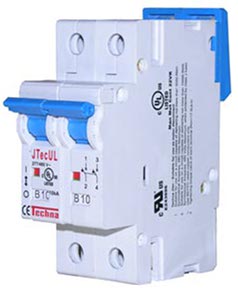Circuit breaker
A circuit breaker, short -outs, colloquially breaker or short machine, or fuse called, is an overcurrent protection device in the electrical installation and is used in low voltage distribution systems. It protects cables from damage caused by heating due to high current. The circuit breaker is a reusable, not self -resetting fuse element. It was invented in 1924 in the company of Hugo Stotz in Mannheim.
A combination of a circuit breaker with a residual current circuit breaker is called RCBO ( Residual current operated english Circuit Breaker with Overcurrent protection).
General
As a fuse or a circuit breaker, he can turn off the circuit when overload and short circuit automatically. Non- adjustable power switches are in accordance with current standards referred to as circuit breaker ( CB ) and are discussed in this article.
For Germany applies for new installations (after the TAB in conjunction with DIN 18015-1 ):
- In the power distribution of apartments only circuit breaker may be used for lighting and socket circuits. Fuses are only permitted for permanently connected devices (eg heater) or as a fuse for sub-distributions.
- To hedge upstream of the meter selective circuit breaker (SLS ) can be used. NH fuses are only permitted in this application if another " amateur -use activation ability of customers complex", eg as Nachzählersicherung is a Neozed switches, disconnectors, given.
Operation
The shutdown can be triggered in four ways:
Free tripping
An important feature of circuit breakers is the tease- free mechanism. It ensures that in case of short circuit, immediate release also takes place when the shift lever is pressed or held in the on position.
After an overload trip the bimetallic strip must be allowed to cool before a restart is possible. The fact that they have to be turned on by a manual switching action again, the user is alerted to a possible error.
Tripping Characteristic
A distinction circuit breaker rated current and next design after the tripping characteristic.
The two values for overload tripping indicate respectively the non-tripping current (small test ) and the tripping current ( high test ). The maximum release time applies to the trip current.
Some manufacturers specify tighter tolerances for the tripping currents during overload and short circuit.
Circuit breakers according to EN 60947-2 (VDE 0660-101 )
1.05-1.2 [20 ° C, 2 hours] 1.05 to 1.3 [30 ° C, 1 hour]
The currently standardized types B, C, D, E, K and Z are marked in the table.
In general, B can be used in residential or office spaces circuit breaker is characteristic. The C-type characteristic for lines to loads with high inrush used ( cable and unit protection).
Miniature circuit breakers with characteristic B are available as standard for the following rated currents: 6 | 10 | 13 | 16 | 20 | 25 | 32 | 40 | 50 | 63 | 80 | 100 | 125 amps. Depending on the manufacturer, other values are available. C and D machines and circuit breaker type K and Z are available in greater variety of types with values far below 1 A.
The H- characteristics have been used since the 1950s for household circuits to reliably achieve at short circuit in networks with high impedance or protective grounding quick release. In the present network conditions the sensitive short-circuit release may undesirably respond. This affects, for example, Consumers with switching power supply ( computer, television ) or motors ( vacuum cleaners). In such cases, the exchange is recommended by B point. H10A can usually be replaced by B13 (same overload characteristics).
Special attention is needed in the selection of circuit breakers in securing electronic loads (ballast, switching power supplies ), as their high inrush currents are observed.
Tripping for short circuit
Circuit breaker must be able to switch off high short circuit currents. The breaking capacity are graded as follows:
There are also requirements for the short-circuit current limitation. In Germany applies after TAB for miniature circuit breakers up to 32 A, the energy limiting class 3 (selectivity Class 3, " high standards "). In case of short circuit of only by the network impedance ( internal resistance ) is certain current ( " prospective short -circuit current " ) is very high. The circuit breaker limits the short circuit current by design to a lower value. A high energy limit results in a high selectivity to upstream fuses and protects the system against electromagnetic influences.
Design
Miniature circuit breakers have a plastic housing. Older versions were cylindrical and were used instead of the usual screw- in the Edison screw or bolted to a thin metal rail. Modern miniature circuit breakers have rectangular enclosure and can be mounted side by side close to the mounting rail ( top hat rail).
Single-pole circuit breakers, today most 1 module wide.
Two-pole versions are made with 2 TE, TE 1.5 or 1 TE width. Three - and four-pole machines are correspondingly wider. There are also miniature circuit breaker with 1.5 HP width per pole. These are usually those for rated currents from 80 A - 125 A and / or with a very high breaking capacity. The selective circuit breakers, 2 units wide. They are mounted on a busbar (40 mm bar center distance ). Alternatively, the selective miniature circuit breakers are mounted on normal rails, but they do not fit into conventional small distribution.
If the circuit breakers are also switches the neutral conductor, the contact for the neutral conductor must open and close voreilend delayed.










